I’ve noticed an interesting trend throughout my Pokémon TCG career: the more I’ve improved at the game, the less attuned I’ve been to upcoming set releases and future formats. While I think this is because I spend more time perfecting lists and gameplay for whatever format I currently have to play events in, it does sometimes mean I’m behind the curve when a new set drops. With online tournaments more prevalent now than a couple of years ago, brand-new cards are seeing tournament play literally the day after they’re released in some cases, and players who have already been deckbuilding and testing the new format are at an advantage.
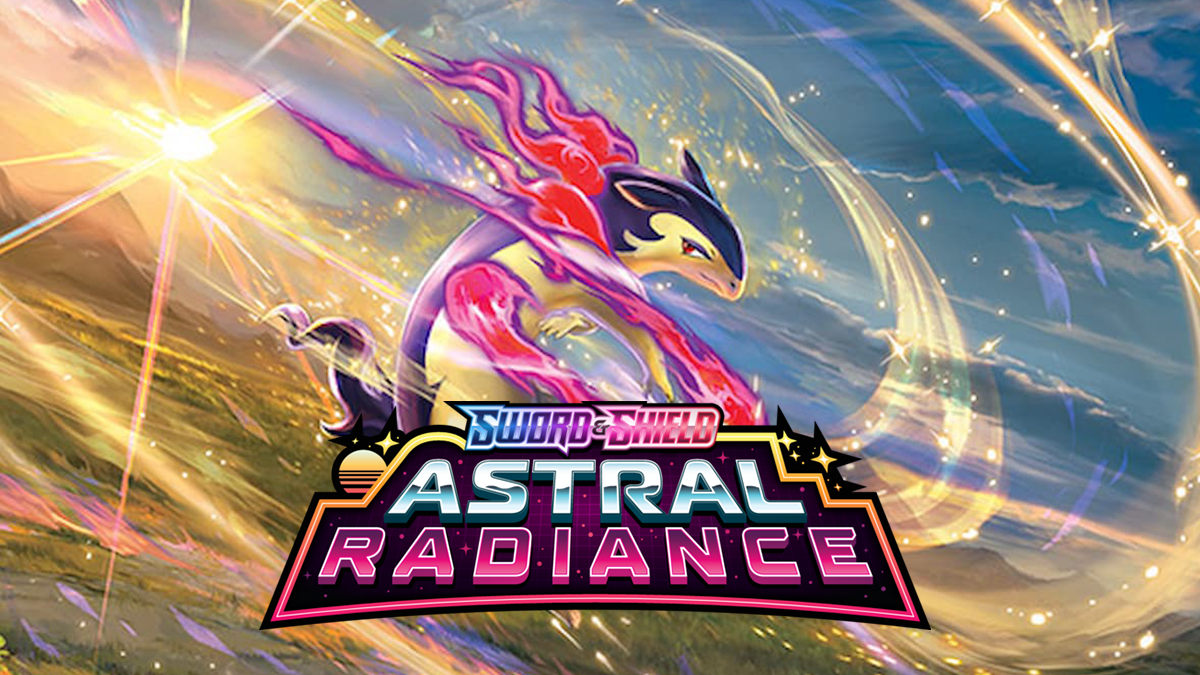
With Astral Radiance releasing today, May 27th, I decided to be a bit more proactive than usual and start doing some deckbuilding with the new set to prepare myself for some events this summer. Another consequence of procrastinating on exploring new sets is that you often end up net-decking lists that have already been posted by content creators such as Tricky Gym or JustinBasil, even when these lists may be very rough. This has been the case for me for the last few sets, where I simply picked up lists my friends sent me for the first few days of the format, and did not give serious thought to refining lists or building them from scratch until the format had developed somewhat.
Although you can already find some draft Astral Radiance lists online (and I’m sure other creators such as Celio’s Network and OmniPoke will be posting some soon), I didn’t want to look at them until after I’d done some of my own deckbuilding, at least for the specific archetype I’ll be discussing in this article. I wanted to go through the process of building a list completely from scratch because it would force me to look through both Astral Radiance and past sets to refresh my memory on the Standard card pool. By doing this, I might come across some underappreciated cards or unexplored combos, or simply gain greater knowledge of the Standard card pool for use in future list refining.

In particular, the Astral Radiance archetype I was drawn to most was Palkia VSTAR. While I never intend to pigeonhole myself to a single archetype, I have been playing a high amount of Melony-centered decks for several months now, including the Ice Rider Calyrex VMAX and Suicune V decks I’ve written about here on Flipside. Palkia VSTAR continues in this vein of decks by being a two-Energy-cost, Water-type, strong attacker that synergizes with Melony as well as with the Drizzile-Inteleon engine that has become the centerpiece of current Standard deckbuilding. Most players predict Palkia VSTAR to be one of the top archetypes in Standard upon release. However, like Suicune and Ice Rider, the deck is going to be somewhat linear as a result of the Melony engine, even with the flexibility afforded by Drizzile. Playing a simple and consistent aggro deck has been a recipe for success in Pokémon before, but oftentimes as a format progresses, these decks are countered by the top players in the game creating more complex counter decks that have more flexibility. (Think of Mew VMAX being gradually countered by Arceus VSTAR toolbox decks or decks like Stéphane Ivanoff’s Lille Regionals-winning Galarian Moltres build.) We will see how Palkia VSTAR fares later on in Astral Radiance Standard, but it should be a top deck for the early days of the format at least. With this in mind, I wanted to assemble a Palkia deck that is consistent but still has some flexibility or interesting card choices to increase its skill ceiling in tournaments.

First things first, let’s talk about the key cards in Astral Radiance that brought this archetype into existence in the first place. Palkia VSTAR looks to be the second major VSTAR (after Arceus) to ascend to a tier one archetype in the Standard format immediately upon release. Its attack is strong— 60 damage plus 20 more for each Benched Pokémon in play— but nothing we haven’t really seen before from Suicune V, with the slight damage buff mediated by Palkia VSTAR being functionally a Stage 1 and not a Basic. The major draw of Palkia VSTAR is its VSTAR Ability, Star Portal, which lets you attach 3 Water Energy cards to your Pokémon however you like once during a game. This adds a new dimension to Standard Water archetypes as Palkia VSTAR decks no longer need to be as reliant on Melony as Suicune V or Ice Rider Calyrex VMAX are— you can use Star Portal to power up an attacker for the turn and then play a different Supporter to further enhance your position.
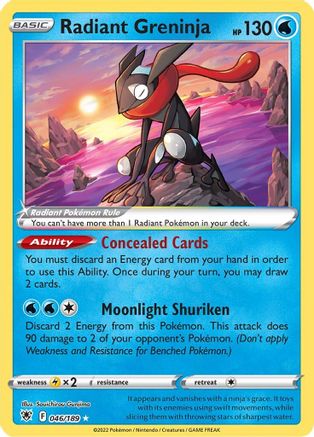
One new attacker enabled by Star Portal is Radiant Greninja. Radiant Greninja combines a couple of attributes reminiscent of top-tier cards from the past and current Standard. Calling back to Zoroark-GX (or Cinccino today), its Concealed Cards Ability lets you discard an Energy card from your hand once per turn to draw two cards. This synergizes well with Palkia VSTAR, as you want Energy in the discard pile for Melony, Raihan, and Star Portal, plus it is another way to draw out of hand disruption such as Marnie or Roxanne (which I’ll discuss shortly) in the late game. But it’s not just a support Pokémon: Radiant Greninja emulates Rapid Strike Urshifu VMAX with its Moonlight Shuriken attack, which hits two opposing Pokémon for 90 damage at the cost of discarding two Energy of the required [W][W][C]. While it seems difficult to power up this attack (keep in mind you cannot Melony to a non-V Pokémon), Star Portal lets you do so instantly, and the payoff can be very powerful— just like Urshifu does, you can snipe two support Pokémon (such as Sobble or Drizzile) to ruin your opponent’s setup very early in the game. Moonlight Shuriken can also close out games; for example, you may have damaged a pair of V Pokémon to within 90 HP of being Knocked Out. Suicune V and Ice Rider Calyrex have never had access to a snipe attacker like this, so that’s one new dimension Palkia VSTAR adds that could launch this deck to tier one status.
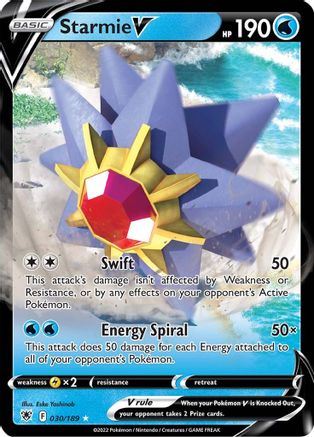
Another Astral Radiance Pokémon being heavily considered in some Palkia VSTAR lists is Starmie V. While not a great attacker in a vacuum, Starmie V is intended as a counter to Arceus VSTAR decks that follow the usual strategy of using Trinity Nova to power up a second attacker. Normally this will leave the Arceus VSTAR player with six Energy in play, at which point Starmie V’s Energy Spiral attack adds up to 300 damage, one-shotting the opposing Arceus VSTAR. Players who oppose adding Starmie V counter that the Arceus VSTAR player can simply choose not to accelerate the full three Energy with Trinity Nova if they know you play Starmie V or see that you are playing Palkia VSTAR. However, if they even accelerate two Energy, Starmie V only needs a Choice Belt to take the OHKO on Arceus VSTAR. If they accelerate fewer than two Energy, they are often severely handicapping their setup, so Starmie may serve the purpose of advancing the game state in your favor even if it isn’t taking an OHKO. Starmie V is likely only a strong attacker in Arceus VSTAR matchups and not many others, so we will have to see how prominent Arceus VSTAR remains in Astral Radiance Standard (and how well it can play around Starmie V) to know if Starmie V is worth including in lists.
Before getting to my list, I’ll finish off this discussion of new cards by going over the new Astral Radiance Trainers that help Palkia VSTAR. While none of them are essential to the deck’s function, they add some additional tricks that continue to make Palkia VSTAR less one-dimensional and better able to respond to different matchups, something that has been lacking from other recent Water decks as I’ve mentioned.
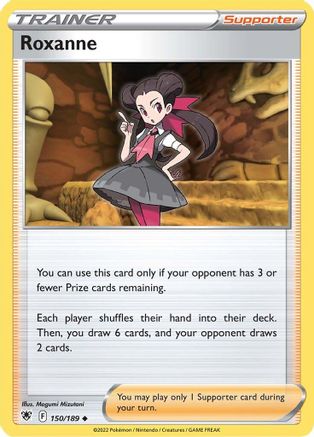
One of the most-hyped Supporters from the new set is Roxanne, which is a modified version of N, one of the best and most beloved Supporters in the game’s history. If your opponent has three or fewer Prize Cards remaining, you can play Roxanne to shuffle their hand down to just two cards while setting your own hand to six. While obviously only playable in the late game, this card is exactly what players have been asking for on their wishlists to improve Standard: a better comeback mechanic. After N rotated, Reset Stamp gave decks a comeback mechanic for a couple of years, but that has been gone for almost a full season now as well. Roxanne enables players to make crazy comebacks after going down significantly in the Prize race, which makes for more exciting and skillful gameplay. Playing around an opposing Roxanne so you don’t brick from it is also a skill from the N and Reset Stamp days that newer players will need to hone. Most Palkia VSTAR drafts include a Roxanne and at least one Path to the Peak, which is a pairing with high potential to brick the opponent in the late game, especially if they have not thinned their deck well. The consistent damage of Palkia VSTAR and options such as Radiant Greninja can then help you build a comeback.
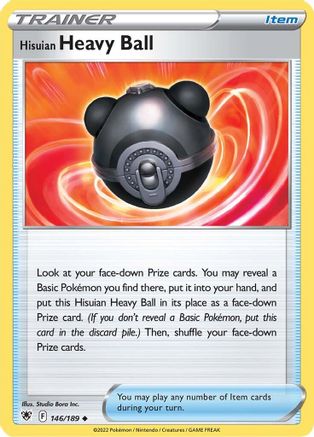
Two other Astral Radiance Trainers some players are trying in Palkia VSTAR are Hisuian Heavy Ball and Temple of Sinnoh. The former can be exchanged with a Basic Pokémon from your Prize Cards, which is useful if you Prized Radiant Greninja (since you can only have one Radiant Pokémon in your deck), but can also serve as a fifth Quick Ball if you Prized a Palkia V (which should happen in about 31% of games), giving you additional search outs to finding that all-important turn one Palkia V. I don’t know for sure if Hisuian Heavy Ball is worth including just yet, but it hasn’t been bad in my early testing.
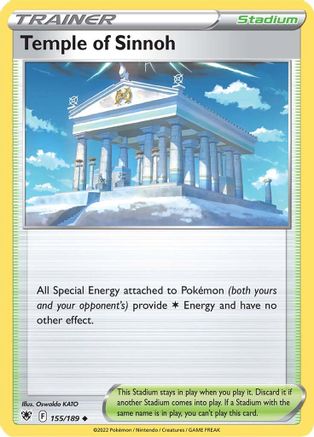
As for Temple of Sinnoh, some players are hyping it as a soft counter to Arceus VSTAR, as it turns their Double Turbo Energy into just a single Colorless Energy, making it more difficult for them to use Trinity Nova. I don’t think this Stadium is as good as some are making it out to be. If you play it down when your opponent has yet to use Trinity Nova, they can simply replace it with their own Stadium on their own turn to remove the effect. Temple of Sinnoh is also anti-synergistic with Starmie V, reducing your damage output by 50 for each Double Turbo Energy on your opponent’s board. I suppose in theory a late-game Roxanne + Temple of Sinnoh combo could be more disruptive than Roxanne + Path to the Peak in certain scenarios, but they don’t seem common enough to justify playing a copy of Temple of Sinnoh. It’s possible that in testing I find it to be more valuable than, say, the Hisuian Heavy Ball and want to include a copy, but I can already think of more valuable techs I’d rather include. I’ll discuss some of those techs after showing my current list.
Card Explanations
Pokemon


I think a 4-3 Palkia VSTAR line should be the norm for this archetype, and of course a minimum of 4-3 Drizzile as well. The major questions are whether a fourth Drizzile should be played and what the correct split of Inteleon is. I am starting with one each of the Shady Dealings and Quick Shooting Inteleon, although testing may reveal that a second copy of one of them could improve certain matchups. For instance, damage from multiple Quick Shooting adds up rapidly to push for OHKOs on Pokémon that may be just out of reach of Palkia VSTAR, for example when your opponent is limiting their Bench. Also, a second Shady Dealings Inteleon would slightly improve your odds of drawing out of opposing Roxanne, as long as you’re able to maintain an unevolved Drizzile in the late game.


Another debate is whether Crobat V is better than Lumineon V, or even whether both (or neither) should be played. I like Crobat V both for the early-game burst potential (where finding a Palkia V and an Energy is typically your top priority) and for late-game draws out of Roxanne when you might need more than just a Supporter for your winning combo. However, Lumineon V’s ability to guarantee a specific card (even if the options for that card are limited to Supporters) does make it stronger in certain scenarios. Also, Lumineon V can be a viable attacker in this deck because of Star Portal, whereas it was usually too inefficient to bother setting up in decks like Ice Rider Calyrex VMAX. If you run Lumineon V, Frank Percic likes the idea of including a single Battle VIP Pass and at least one Irida (a new Astral Radiance Supporter that is a Water-focused reprint of Korrina), so that you can grab Battle VIP Pass on turn 1 going second and set up your board. I don’t love this idea because it relies on a) going second and b) not Prizing any of those pieces, but it is something to test.
I am sticking with Starmie V in this initial list, but will know after more testing whether it really does enough in the Arceus VSTAR matchup to be worth keeping in the deck. It is worth noting that if the new Darkrai VSTAR gains any traction, Starmie V would be a strong tech against that, but we don’t know exactly how much play that archetype will see yet.

Finally, I am including a copy of Manaphy because I expect Rapid Strike Urshifu VMAX to make a bit of resurgence in Astral Radiance Standard after some poor showings at the most recent Regionals. Arceus VSTAR players have been including a veritable army of techs (Dunsparce, Manaphy, Hoopa V) that pretty successfully kept Rapid Strike Urshifu VMAX at the bottom tables in Santa Catarina, Indianapolis, Perth, Lille, and New Jersey. However, I think these techs will die down a bit as we move into a new and unexplored metagame, and Rapid Strike Urshifu VMAX also gains some new matchups to prey on that can less effectively utilize those techs. I don’t want to risk autolosing to Rapid Strike Urshifu VMAX in this blind format by having no response to G-Max Rapid Flow. Manaphy also helps greatly in the mirror by hindering opposing Radiant Greninja, and if Palkia VSTAR is as highly played as I expect, that alone might justify Manaphy’s inclusion.
Supporters



A very rough draft that I Tweeted had three Melony, but I think that is excessive since Star Portal means Palkia VSTAR doesn’t play exactly the same as Suicune V or Ice Rider Calyrex VMAX. Two copies should be fine for executing your setup, since Star Portal can help set up additional attackers and free you up to play a “better” Supporter on other turns. I think Professor’s Research will be a common early-game Supporter for this deck, and I included one Marnie as well for the option to disrupt an opponent before Roxanne activates, or simply to reset a hand where you don’t want to discard resources. Boss’s Orders and Roxanne are fairly obvious staples; I have seen some lists with Cross Switcher (following Phinn Lynch’s Utah finalist Suicune V list), but haven’t personally tested this yet and am not sure if the deck has room. On paper, though, the integration of Cross Switcher with a fast Melony deck such as this one does seem strong. Raihan is also an important Supporter for Water decks to play because, among other things, it allows you to easily attack with Inteleon SSH, which is actually a very good attacker in a lot of games. It can two-shot VSTARs with Choice Belt, set up math on the Bench with snipe damage (especially with Quick Shooting and Radiant Greninja later), and most importantly can force a seven-Prize game.
Everything Else
I already discussed some of the niche inclusions such as Hisuian Heavy Ball and the possible inclusion of Temple of Sinnoh, but there are some other one-ofs I’ve fit into this list because of the nature of the Drizzile engine, allowing me to find those single copies exactly when I want them.

-
Escape Rope: I’ve been including Escape Rope in my Melony decks for a while now because obviously you cannot use Melony and Boss’s Orders in the same turn, so Escape Rope serves as a “pseudo-Boss” on turns when you just need to take Prizes. I also think this deck needs a pivot card because sometimes you want to move Palkia V or VSTAR but don’t want to discard two Energy.

-
Echoing Horn: Echoing Horn has obvious synergy with Palkia VSTAR because it instantly boosts your attack by 20 damage if your opponent has any Pokémon in their discard pile. Sometimes that 20 can be the difference between KOing and not. Also, Echoing Horn can just instantly win the game sometimes if you have two Prizes left and can put a low-HP V Pokémon onto your opponent’s board, then pull it up with Boss’s Orders. I think Echoing Horn should be a staple in this archetype.


- 1 Path to the Peak / 1 Training Court: I mentioned Path to the Peak already for the late-game disruption combo with Roxanne; there may also be occasional games when an early Path + Marnie could prevent an opponent from setting up. However, I recognized early on that you need to play one additional Stadium (or a Pumpkaboo, but I’m not sure the Bench spot is justifiable) to bump opponents’ Path to the Peak as well. Temple of Sinnoh is the one a lot of other players are focused on, but I went for Training Court as I think it provides more utility in a much broader set of game states and matchups than Temple of Sinnoh does. One of the minor issues with Ice Rider Calyrex VMAX I found in the past format was that you could occasionally whiff an Energy in the late game if you ran out of Capacious Bucket (because nothing else could directly search for them); Training Court solves this problem for Palkia VSTAR. However, I don’t think the text of the Stadium matters nearly as much as the fact that you have some non-Path card that says “Stadium” and can turn your Star Portal and Dark Asset back on.


Counts for my Item engine are very straightforward; I just went with full playsets of all the major ball search cards in Standard. I have never liked Ultra Ball in Melony decks as the resource loss is often too steep, and the turn one consistency in this list with Crobat V and Hisuian Heavy Ball on top of the 4 Quick Ball should be very high.

Two Scoop Up Net allows you to reuse Drizzile and Inteleon throughout the game and can also enable the double (and rarely even triple) Quick Shooting turn which can be very strong in niche scenarios. Scoop Up Net also allows you to add some additional techs such as Pumpkaboo or Zigzagoon should you end up wanting those.

Choice Belt is very important to allow Palkia VSTAR to push for OHKOs on opposing VSTARs, especially when your opponent is limiting their Bench. Between Choice Belt, Echoing Horn, and Quick Shooting, you have numerous ways to modify your damage output and respond to your opponent playing around you. Some other “magic numbers” Choice Belt hits are allowing Inteleon SSH to 2HKO VSTARs, and allowing Starmie V to OHKO Arceus VSTAR when the Arceus player has only five Energy in play.

Finally, I think 2 Capacious Bucket/8 Water Energy is a solid split, but I will monitor these counts in testing. I have played 3 Bucket in most of my previous Melony decks because it helps your consistency so much (and running out of Bucket in the late game, or using one early and Prizing the second, can be dangerous), but 2 is acceptable unless my Palkia VSTAR testing finds otherwise. I played a total of 7 Energy in my Suicune V and Ice Rider Calyrex VMAX lists, but I think Palkia VSTAR will require at least one more Energy because of the high attack cost of Radiant Greninja, the fact that you will be playing Melony less often, and the fact that you want multiple Energy in the discard pile for Star Portal.
Some Notes on Counters


With Palkia VSTAR receiving a lot of hype, players are already looking ahead to countering this archetype with existing decks. One common idea is Arceus VSTAR players incorporating Flying Pikachu VMAX or Tapu Koko VMAX, as seen in some Japanese tournaments. I don’t think this strategy is foolproof because the Palkia VSTAR player can simply use Boss’s Orders to KO the Basic V for those attackers before they can evolve, and anyway VMAX Pokémon won’t trade particularly well with your VSTARs if you can leverage Inteleon as a seventh-Prize attacker. I would be much more concerned about Arceus VSTAR (or other decks) teching Raikou V, or even some single-Prize toolbox decks that might crop up running Zeraora FST. If these become prevalent in the metagame, Palkia VSTAR will either need to adjust decklists accordingly, or simply see less play until the techs start to die down again.


Another criticism I’ve seen of Palkia VSTAR is that it will do poorly against Roxanne, with limited ways of dealing with having a two-card hand in the late game if you have no available Drizzile or cannot use Crobat V due to Path to the Peak. I think adequate deck thinning will shore up this problem somewhat, as could a second copy of Inteleon SSH as I mentioned previously (or even something like a third Scoop Up Net), but there are other deckbuilding strategies you can use to mitigate Roxanne. Stéphane Ivanoff likes the idea of a 1-1 line of Bibarel, which I think many decks might start to do as Roxanne and Jolteon VIV become part of the Standard meta. An idea from Jake Gearhart involves adding a Mew CEL and an Air Balloon, giving you a pivot after your opponent plays Roxanne and takes a KO, with the Mysterious Tail Ability able to potentially bail you out by finding a search card. I need to test this idea, as it seems a bit flimsy, but strong if it works consistently. Mew is also a nice Pokémon for the deck to open with every so often.
Conclusion

Palkia VSTAR looks like a deck that is simultaneously fun, skill-rewarding, and very strong, with most top players approaching it as a tier one archetype. I don’t think the deck is particularly complex relative to other archetypes, but it does still leave room for skill expression with Star Portal, Radiant Greninja, playing around Roxanne, and especially the way you build your list. It’s a deck I envision myself bringing to some tournaments this summer if the metagame seems alright for it. However, my Astral Radiance testing is just beginning and the list I shared here is certainly open to adaptation in the coming days.
If you want to continue the Palkia VSTAR discussion, have any questions, or are interested in coaching, you can always reach me on Twitter @twhitesell42. Be sure to follow my team UNDNTD as well; my teammates and I will have some gameplay and deckbuilding strategy tips for the new format arriving on our YouTube channel soon. I’ll plan to have another article here on Flipside in early June, going over some more Astral Radiance lists and testing updates. See you then!













